Jun 6, 2014 | celebration, commemorative, commentary, foreign, history
Operation Overlord was the largest amphibious invasion in history.
Originally scheduled on May 1, it was rescheduled to June 5 and then June 6 because of weather.
Commanded by Gen. Dwight D. Eisenhower, the invading force consisted of 156,000 Allied troops using 5,000 ships and landing craft bringing on shore 50,000 vehicles with overhead support from 11,000 planes and 13,000 paratroopers.
Across 50 miles of Normandy coast line, the United States forces were assigned Utah and Omaha beaches, the British Army was assigned to Gold and Sword beaches, and the Canadian Army invaded Juno beach.
Operation Bodyguard created six decoy invasions as a distraction to the Germans so as to divert their attention from the intended invasion at Normandy. Gen. George S. Patton, considered the most skillful tank commander in U.S. military history, commanded a fake mission to invade Pas-De-Calais.
Omaha Beach was the focus of the attack because it was the most heavily defended beach.
On the first day, 4,414 Allied soldiers were confirmed dead.
Victory was declared on July 21, 1944 when the Allied forces captured Caen, one of the major objectives of the invasion.
The Normandy American Cemetery in Colleville-Sur-Mer is the final resting place for 9,387 Americans. Across its 172.5 acres sits 9,238 crosses and 149 Stars of David where 41 sets of brothers and 3 Medal of Honor recipients rest. The Walls of the Missing is engraved with the names of 1,557 soldiers missing in action.
On this, the 70th Anniversary of D-Day, the day Operation Overlord began, there is one more statistic that should not exist:
The number of commemorative coins issued by the United States to honor those that served and gave their lives to help begin the liberation of Europe from the worst criminal of all time: ZERO!
Although the U.S. Mint did issue a World War II 50th Anniversary commemorative coin in 1995, this country should honor those who participated in the largest amphibious invasion in history and set the world on a safer course.
With the number of veterans of that day dwindling as they are all nonagenarians, I would like to thank them for their service and the families of the fallen for their service. I only wish that congress would realize that their bickering over nonsense with flags on their lapels pales in comparison to the sacrifices made on that day in France. They just do not get it.
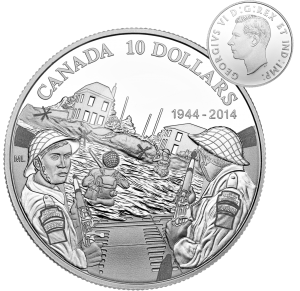
Canadian $10 Commemorative of the 70th Anniversary of D-Day featuring the obverse portrait of King George VI, the reigning monarch at the time of the invasion.

70th Anniversary of D-Day 2014 Alderney £5 BU Coin from the Royal Mint.
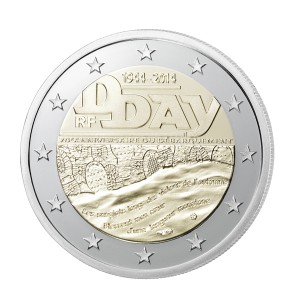
Bimetallic 2 € commemorative issue from the Monnaie de Paris (Paris Mint)
May 26, 2014 | celebration, commentary, history, medals, US Mint

Cherokee Nation Code Talkers Medal
The next year, southern states began their own Memorial Days to honor their soldiers who died during the war. No specific date was used but occurred in late April through June. By 1880, there was a more organized Confederate Memorial Day. These celebrations honored specific soldiers to commemorate the Confederate “Lost Cause.” By 1913, a sense of nationalism saw a commemoration of all soldiers that have died in battle.
In the north, the fraternal organization of Civil War veterans The Grand Army of the Republic began organizing “Decoration Day” in 1868. Decoration Day was to honor the fallen by decorating the graves of Union soldiers with flowers and flags. Ceremonies included speeches that were a mix of religion, nationalism, and a rehash of history in vitriolic terms against the Southern soldiers. The acrimony against the South began to subside by the end of the 1870s.
Memorial Day did not take on national significances until after World War I. Rather than being a holiday to remember those of died in service during the Civil War, the nation began to recognize all those who gave the ultimate sacrifice during all conflicts. By the end of World War II, most of the celebrations were renamed from Decoration Day to Memorial Day. Memorial Day did not become an official holiday until 1967 and its date changed from the traditional May 30 to the last Monday of the month by the Uniform Holidays Act (Public Law 90-363, 5 U.S.C. § 6103(a)) in 1968.
Regardless of how you view the current world conflicts, the men and women who serve in our military deserve the honor and respect for their service. Pray for their ability to safely return home.
We will resume numismatic writings shortly.
Apr 23, 2014 | history, scripophily
If education is a lifelong project, then numismatics is the perfect vehicle for continuing education. If you are only collecting the metal, the plastic surrounding the metal, or the paper without understanding the stories behind them, then you are missing the richness of the story behind those objects. These stories makes those coins, paper, medals, and tokens come alive.
 Let’s take the story of some paper, but not just any paper. This paper are of stock certificates of companies gone by. But not just any companies. These are railroads that are featured on the board game Monopoly.
Let’s take the story of some paper, but not just any paper. This paper are of stock certificates of companies gone by. But not just any companies. These are railroads that are featured on the board game Monopoly.
The railroads in the game are based on real railroads that had an effect on Atlantic City, New Jersey in one form or another. The Reading Railroad and Pennsylvania Railroad served Atlantic City. Although the Baltimore and Ohio (B&O) Railroad did not serve Atlantic City, it was a major feeder railroad to both the Reading and B&O.
But the game has one railroad, the “Short Line” which was claimed to never exist but was a combination of rail lines. But that story bothered me, so I went on a search for what was the real Short Line Railroad.
After several web searches and reading various references, I was lead to the book Monopoly: The World’s Most Famous Game And How It Got That Way by Philip E. Orbanes. According to many, it is the definitive book about Monopoly.
I purchased the book and learned that the Short Line was really a railroad. Well, it was actually the shortened name of a service called the Shore Fast Line, an electric streetcar that ran between Atlantic City and Ocean City. It was one of such short rail services operated by a company named the Atlantic City and Shore Railroad.

Shore Fast Line Ticket
(image courtesy of sjrail.com)
The railroad was founded in 1906 when the West Jersey and Seashore Railroad electrified their main line with the financial help of the Stern and Silverman Syndicate. The new company was chartered as the Atlantic City and Shore Railroad. Although the first cars began to run in 1906, the full line became operational in 1907. The company was dissolved in 1945 after its sale to the Atlantic City Transportation Company, who were buying the small railroads in New Jersey. The new company continued to operate the Shore Fast Line until 1948. Atlantic City Transportation Company stopped running all trains in 1955. They continued to operate busses until 1985 when New Jersey Transit took over the service.
Numismatists who collect scripophilly (the study and collection of stock and bond certificates) who knew about the B&O, Pennsylvania, and Reading railroads and wanted to create a Monopoly collection can start to look for the stock certificate of the Atlantic City and Shore Railroad to properly complete the set. The problem is that the stock certificate for the Atlantic City and Shore Railroad is rare as compared to the other three meaning it can cost significantly more to obtain.
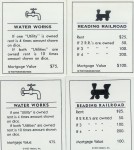 I found an unissued stock certificate for the Atlantic City and Shore Railroad at the site for George H. LaBarre Galleries, Inc., a company in Hollis, New Hampshire. For such a rare stock certificate in excellent condition, the $75 price tag seems reasonable. LaBarre also sells the “Monopoly Game Board Set” with the B&O, Pennsylvania, and Reading Railroad stock certificates.
I found an unissued stock certificate for the Atlantic City and Shore Railroad at the site for George H. LaBarre Galleries, Inc., a company in Hollis, New Hampshire. For such a rare stock certificate in excellent condition, the $75 price tag seems reasonable. LaBarre also sells the “Monopoly Game Board Set” with the B&O, Pennsylvania, and Reading Railroad stock certificates.
With all four certificates, you can add the cards from a real Monopoly game, $200 in Monopoly money for each, plus $200 for the rent that would have to be paid if someone landed on your railroad. You should also find the “Take a Ride on the Reading” and “Advance token to the nearest Railraod and pay owner Twice the Retal…” cards. Put it all together in a frame and hang it in your game room.
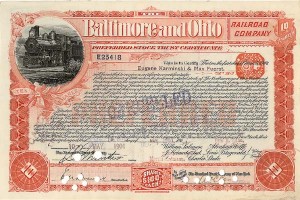
Baltimore & Ohio Railroad.

Pennsylvania Railroad stock certificate with famous horseshoe curve train scene.
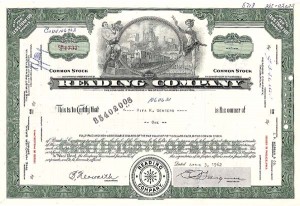
Reading Company, owner of the Reading Railroad.

Atlantic City and Shore Railroad, operator of the Shore Fast Line (Short Line in Monopoly)
And with that, you can have a lot of fun with the part of numismatics known as scripophilly!
I have no connection with
George H. LaBarre Galleries. Since I am using their images, I think it is only fair to give the company credit and, hopefully, steer some business their way. So if you are interested in these or other scripophilly items,
shop their online catalog!
Mar 8, 2014 | Carson City, coins, gold, GSA, history, news, rareties, US Mint

One of the cans found as part of the Saddle Ridge Gold Coin Hoard
This is not to say that treasures can only be found in California. As someone who has started a business dealing with collectibles, I have found interesting items at good prices in the most unexpected places. The concept is not to start digging where someone else made their discovery but look for clues to new finds elsewhere. Chances are that the next find will not be the same area.
One of the more interesting aspects of the Saddle Ridge Hoard story is the speculation of where the coins came from and why were they buried in that location. The most entertaining was the story that these coins were stolen in 1901 from the U.S. Mint in San Francisco. Even though it sounds plausible, the details of what would have happened based on historical record does not support this theory.

The old San Francisco Mint building built in 1874
Also, the U.S. Mint is not a bank. It does not save inventory. Records† show that over the years, the U.S. Mint loathes keeping inventory for long periods of time. These sources report a revolving inventory suggesting that only the 1933 Double Eagles may have been kept in the vaults longer than other coins while the policies about gold coins were being settled.
Anticipating the question about the GSA Hoard of silver dollars, those coins were not stored by the U.S. Mint. Those dollars were delivered to the Department of the Treasury to use as backing for silver certificates. The storage areas where the coins were found were either facilities used or leased by Treasury. Coins that were melted under the Pittman Act for sale to the British to help them fund their defense in World War I were coins held by the Treasury. Coins struck to replace the melted coins were then stored in Treasury facilities.
When the General Services Administration (GSA) worked to consolidate and reduce office space in the 1960s, millions of mostly Morgan dollars struck in Carson City were found in several buildings including in storage areas off the historic cash room in the Treasury Building in Washington, D.C. Coins were sold the public by sealed bid over five auction sales between 1972 and 1974 with one final sale in 1980.
Up until 1964, anyone could trade a silver certificate for silver coin at par (e.g., $1 silver certificate for one silver dollar). This ended when silver rose in price making the price of silver more expensive than par value.

One of the 1,427 “Saddle Ridge Hoard” buried treasure gold coins certified by PCGS
Saying that the Saddle Ridge coins were once stolen from the Mint makes for a good headline. Good headlines makes for page views and page views translates into more advertising dollars for those blindly reproducing the erroneous story without checking the facts. Unfortunately, the truth cannot be explained on a bumper sticker or in a sensational headline—but that does not mean I will not try!
See the Saddle Ridge Hoard at Whitman Baltimore
It is being reported that Don Kagin will bring many of the coins in the Saddle Ridge Hoard to the Whitman Expo that will be held March 27-30, 2014 at the Baltimore Convention Center. If you need an excuse to come to Baltimore aside from attending the largest coin and currency show that is not run by the American Numismatic Association, coming to see the Saddle Ridge Hoard before it is broken up and sold later this year.
† A good reference for U.S. Mint statistics is a government-produced publication named Domestic and Foreign Coins Manufactured by the Mints of the United States: 1792-1965. It has been scanned several times and can be found on one of the many archive sites. The problem is that I found only one good scan, and it is not the best, but forgot where I downloaded it from. Printed copies are even more difficult to find.
Credits
- Image of the can of gold coins from the Saddle Ridge Hoard courtesy of Kagin’s.
- Image of the old San Francisco Mint courtesy of Wikipedia.
- Image of the graded eagle courtesy of Professional Coin Grading Service.
Dec 25, 2013 | base metals, cents, coins, commentary, dollar, Federal Reserve, gold, history, Morgan, Peace, silver, US Mint
Two discussions that transcended numismatics is what to do about the one dollar coin and common one-cent coin. Both coins cause different problems depending on who is doing the arguing. I find it amazing that the logic that is used to support the argument is not used consistently.
Dollar coins have been around since the beginning of the republic. In fact, the coin that currently holds the record for being the most expensive coin sold at auction is a 1794 Flowing Hair dollar. The coin is reported to be amongst the first dollar coins minted at the newly created Mint was bought by Legend Numismatics for more than $10 million. Laura Sperber, one of the principals of Legend Numismatics, was quoted as saying that she was prepared to bid higher for the coin.
If that is not enough to show how important the dollar coin has been in our history, there is always the 1804 Bust dollar, also known as “The King of Coins.” The U.S. Mint ceased to strike dollar coins in 1804 because of hoarding when the price of silver rose. The dollars that were struck in 1804 were struck using dies dated 1803 and are indistinguishable from the coins struck in 1803. The U.S. Mint continued to strike “minor coinage” to encourage circulation.
In 1834, eight dollar coins were struck with the 1804 date to include in a special set created as a gift for the King of Siam (the area known today as Thailand). One coin was included in the set, one was retained by the U.S. Mint for its collection that is now part of the National Numismatic Collection at the Smithsonian National Museum of American History, and the six others were kept as souvenirs by Mint officials and eventually landed in private collections. Between 1858 and 1860 seven more specimens were surreptitiously by U.S. Mint employee Theodore Eckfelt. It is alleged that Eckfelt created 15 coins. Six are in private collection, one is now part of the National Numismatic Collection and the others were reported to be destroyed when seized by the government.
The Coinage Act of 1873, known as “The Crime of ’73,” ended the free coining of silver and put the United States strictly on the gold standard until the western states where silver was being mined became upset. Two weeks later, congress passed the Bland-Allison Act to required the Department of the Treasury to buy the excess silver and use it to strike the Morgan Dollar. Morgan dollars, especially those struck at the branch mint in Carson City, Nevada are popular with collectors because of their ties to the days of the old west. Collectors can find quite a few nice examples of Morgan and the Peace dollars that were struck from 1921 through 1938 because many did not circulate. These coins were held as backing to silver certificates in circulation and did not get released to the general public until the GSA Hoard sales that begin in the 1960s.
Such a colorful history also has a downside that is used as fodder against the dollar. After ending the production of the Peace dollar in 1938, no dollars were struck until 1964 when the U.S. Mint struck 316,076 1964-D Peace dollars in May 1965. The coins were never put into circulation and the entire population of 1964-D Peace dollar were allegedly destroyed. There have been reports that some Peace dollars were struck using base metals (copper-nickel clad) as experimental pieces in 1970 in anticipation of the approval of the Eisenhower dollar. The same reports also presume these coins have been destroyed.
The Eisenhower dollar was not well received because of its size. The 38mm coin was seen as too big for modern commerce and with the exception of dollars struck with the special bicentennial reverse in 1975 and 1976, most coins did not circulate.
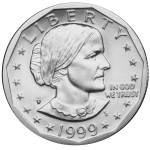
The Susan B. Anthony dollar coin was introduced in 1979 with much fanfare for being the first coin to honor a woman. The coin was a failure because it was confused with a quarter
Since the introduction of the Sacagawea dollar in 2000, the dollar coin’s size has remained the same but with the addition of manganese has a golden color to be visually different from other coins. For the visually impaired, the reeding was removed from the edges. Today, the Presidential $1 coins and the Native American $1 Coins have edge lettering that keeps it tactically different from the quarter dollar. However, people continue to bring up the Susan B. Anthony dollar as a reason not to use dollar coins.
Historically, dollar coins has been more popular in the western regions of the United States where the east prefers paper. Financial centers and big city government prefers paper for its alleged ease of handling. When circulated side-by-side, the public tends to choose paper over coin.
When we look around the world for examples of how to handle this situation, we find that the United States is the only country where the unit currency is available in both paper and coin. Other countries did not give people a choice. Rather, their governments made a decision based on overall economic benefits of using a coin with a predicted 30-year lifespan over paper currency that can last 18-24 months in circulation. Instead of the argument being of practical economics where every other country and the European Union have put on their proverbial long pants and made a decision that is in their best economic interest, factions in the United States comes up with mind boggling arguments of alleging that taking the paper dollar away is akin to taking away our freedom.
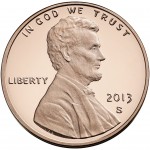
Obverse of the 2013-S Lincoln proof cent. Lincoln’s portrait, designed by Victor D. Brenner in 1909, is the longest running design of any United States coin.
The United States has a history of using its currency to boost the economic status of its citizens, aside from the various silver laws and the laws that eventually took the United States off the gold and silver standards, the creation of the half-cent was made because of the economic status of its citizens. Following Alexander Hamilton’s Treasury Secretrary’s report to congress “On the Establishment of a Mint,” Secretary of State Thomas Jefferson had another idea. Jefferson thought it would be better to tie subsidiary coins tied to the actual usage of the 8 reales coin. At the time, rather than worry about subsidiary coinage, people would cut the coin into pieces. A milled dollar cut in half was a half-dollar. That half-dollar cut in half was a quarter-dollar and the quarter-dollar cut in half was called a bit.
The bit was the basic unit of commerce since prices were based on the bit. Of course this was not a perfect solution. It was difficult to cut the quarter-dollars in half with great consistency which created problems when the bit was too small, called a short bit. Sometimes, short bits were supplemented with English pennies that were allowed to circulate in the colonies.
As an aside, this is where the nickname “two bits” for a quarter came from.
Jefferson felt that in order to convert the people from bit economy to a decimal economy, the half-cent was necessary to have 12½ cents be used instead of a bit without causing problems during conversion from allowing foreign currency to circulate as legal tender until the new Mint can produce enough coinage for commerce.
The half-cent would come into focus in the 1850s when the cost to produce the United State’s copper coins was nearly double their face value. In 1856, the Mint produced the first of the small cents, the Flying Eagle small cent, and produced 700 samples to convince congress to change to the small cent. As part of the discussion was the elimination of foreign currency from circulation making the U.S. Mint the sole supplier of coins.
There is no record of outcry from the public on the elimination of the half-cent. Its elimination came four years after the Coinage Act of 1853 that created the one-dollar and double eagle gold coins in response to the discovery of gold in North Carolina, Georgia, and California. The gold rush caused a prosperity and inflation that not only made the half-cent irrelevant but not something on the public’s mint. In that light, the Mint and congress felt that it just outlived its usefulness and would not be necessary with the elimination of foreign currency from circulation.
More controversy was generated in 1857 over the demonetizing foreign coins in the United States than the elimination of the half-cent. While the half-cent continued to circulate, it was estimated that one-third of the coins being circulated were foreign, primarily reales from Mexico. Redemption programs did not go smoothly, but in the end foreign coins were taken out of the market and the American people adapted and it could be said we prospered as a nation.
Like the 1850s, the last seven years have found that the cost of the copper used to make the one-cent coin has increased to more than the coin’s value. Combined with the labor and manufacturing costs, it costs the U.S. Mint between 1.6 and 1.8 cents for each copper-coated zinc cent struck. Although people argue that the cent is not needed and is barely useful, the U.S. Mint reports that 65-percent of its production are for one-cent coins that are ordered by the Federal Reserve to be circulated in commerce.
Eliminating the cent has caused controversy from those concerned with the economic welfare of the less fortunate. Many are using the same arguments that Jefferson made in 1791 to create the half-cent in order to keep the one-cent coin in circulation while others point to what other countries are doing. Canada is currently the country with the largest economy to eliminate its lowest denomination coin. Proponents of eliminating the cent point to Canada’s rocky success (withdrawal of the cent had been delayed twice) as an example of how the United States can handle the situation.

Canadian 1-dollar and 2-dollar coins. The 1-dollar coin is called a Loonie because its reverse depicts a common loon. “Toonie” is a play on the Loonie nickname.
Suggesting that if the United States follows Canada’s lead in the elimination of the cent, should the United States follow Canada’s lead and eliminate the one- and two-dollar Federal Reserve Notes in favor of one- and two-dollar coins?
This debate will continue until someone decides to act like an adult and make a definitive policy decision—especially when the Fed publishes a “working paper” that cherry picks facts to support a specific viewpoint.
Image of the Susan B. Anthony dollar and Lincoln cent courtesy of the U.S. Mint.
Image of the Canadian Loonie and Toonie courtesy of
Noticias Montreal.
Nov 28, 2013 | celebration, history, other

American Abundance designed by Albert Laessle and issued in 1934
After arriving in the New World in 1620, the Pilgrims celebrated their first harvest in 1621. The three-day even was attended by 53 Pilgrims and 90 Native Americans that lasted three days. The tradition of giving thanks for successes was a tradition that the Pilgrims brought with them from England. This three-day celebration in 1621 is considered the first Thanksgiving.
Thanksgiving was celebrated during many different times within the colonies, mainly to give thanks for something that was honorable to the colony or the locality that observed the celebration. The first national recognition of a Thanksgiving celebration came when General George Washington declared December 1777 as Thanksgiving honoring the defeat of the British at Saratoga. As President, George Washington declared the first national Thanksgiving celebration on November 26, 1789. The only other president to issue a Thanksgiving proclamation was President James Madison. From then, it was up to the individual states to declare a Thanksgiving holiday.
As part of his attempt to maintain the union, President Abraham Lincoln issued a proclamation that made Thanksgiving Day a national annual event on the last Thursday in November beginning in 1863.
Thanksgiving remained the last Thursday of November until 1939 when he declared Thanksgiving to be on the fourth Thursday of the month to give merchants more time to sell good during the Christmas shopping season. Congress passed a joint resolution in 1942 fixing Thanksgiving to the fourth Thursday of November.
In 1947, the National Turkey Federation has provided the President of the United State with one live turkey and two dressed turkeys. President Harry Truman is credited with pardoning the first turkey in 1947 but it did not become a tradition until President Ronald Reagan started in 1987 and continued by President George H.W. Bush in 1989. Since 1989, the pardoned turkeys have lived the rest of their lives at Frying Pan Park in Herndon, Virginia. Those pardoned by President Obama have gone to live at George and Martha’s old place in Mount Vernon, Virginia.
Happy Thanksgiving!
Medal image courtesy of the Smithsonian Institute.
Nov 22, 2013 | coins, halves, history, US Mint
It was the modern day “Shot heard ’round the world.” At 12:30 PM Central Time, while the motorcade carrying President John F. Kennedy, First Lady Jacqueline Kennedy, Texas Governor John Connally, and Connally’s wife Nellie was twice fired upon while passing through Dealey Plaza in Dallas. Lee Harvey Oswald fired two shots from the Texas School Book Repository at the convertible. The first shot hit the President under his arm which was held up as he waved at the crowd. The bullet passed through his body and struck Governor Connally. The second bullet struck the President in the head.
At 1:00 PM, President John Fitzgerald Kennedy was pronounced dead at Parkland Hospital.
Vice President Lyndon B. Johnson refused to leave Dallas for Washington without the Jacqueline Kennedy or the body of the president. At 2:38 PM, Johnson took the oath of office aboard Air Force One with Mrs. Kennedy at his side. She wore the blood-splattered coat to remind people of the tragedy that just occurred.
Fifty years later, those who experienced the assassination as part of the American family continues to remember the sadness and grieving by everyone, even those that did not support Kennedy. Some have described the feeling as more profound than what we experienced on September 11, 2001 because while both were tragedies, Kennedy was the living symbol of a bright future.
“We choose to go to the Moon in this decade and do the other things, not because they are easy, but because they are hard.”
—John F. Kennedy
Sept. 12, 1962
Kennedy became the youngest person to ever be elected as President and the first Roman Catholic. At 43, Kennedy was the promise of a new vision that would have the United States leading the world in fighting the “common enemies of man: tyranny, poverty, disease, and war itself.” In his inaugural address, he called the nation to arms for its own sake when he said, “Ask not what your country can do for you, ask what you can do for your country.”
Kennedy made an impact on this country in such a short period of time that one can wonder what would have happened if….
 A few days after Kennedy’s assassination on November 22, 1963, U.S. Mint Director Eva Adams, Chief Engraver Gilroy Roberts reported that there was discussions about putting Kennedy’s portrait on a silver coin. Since Jacqueline Kennedy did not want to replace Washington’s portrait on the quarter, it was decided to use the half-dollar. Roberts used models from the inaugural medal for the obverse design and Assistant Engraver Frank Gasparro prepared the reverse design using the Presidential Seal.
A few days after Kennedy’s assassination on November 22, 1963, U.S. Mint Director Eva Adams, Chief Engraver Gilroy Roberts reported that there was discussions about putting Kennedy’s portrait on a silver coin. Since Jacqueline Kennedy did not want to replace Washington’s portrait on the quarter, it was decided to use the half-dollar. Roberts used models from the inaugural medal for the obverse design and Assistant Engraver Frank Gasparro prepared the reverse design using the Presidential Seal.
Since the law stated that coinage design could not be changed more often than 25 years, and that the Franklin Half was only 15 years old, it required Congress to authorize the change. The Act of December 30, 1963 allowed the design to be changed.
When the coin was released in 1964, the 90-percent silver coin was saved by a grieving nation wanting something that represented the fallen President. Over 273 million coins were struck in Philadelphia and 156 million in Denver. The composition was changed in 1965 with the introduction of clad coinage. Half-dollars consisted of 40-percent silver that included a core made from 79-percent copper and 21-percent silver. In 1971, the composition was changed to current copper-nickel clad that is in use today.
 There has been one design change to the coin and that occurred in 1975 and 1976 in honor of the American Revolution Bicentennial. A special reverse depicting Independence Hall in Philadelphia was designed by Seth G. Huntington. For both years, the obverse featured the dual date 1776-1976 in celebration.
There has been one design change to the coin and that occurred in 1975 and 1976 in honor of the American Revolution Bicentennial. A special reverse depicting Independence Hall in Philadelphia was designed by Seth G. Huntington. For both years, the obverse featured the dual date 1776-1976 in celebration.
On the 50th anniversary of his assassination, we salute President John Fitzgerald Kennedy for his service and mourn the loss to this country.
Nov 19, 2013 | coins, commemorative, history, news
Thursday, November 19, 1863, at the dedication of the Soldier’s National Cemetery in Gettysburg, Pennsylvania, following the the two-hour speech by Edward Everett, President Abraham Lincoln gave short, yet profound address:
Fourscore and seven years ago our fathers brought forth on this continent a new nation, conceived in liberty and dedicated to the proposition that all men are created equal.
Now we are engaged in a great civil war, testing whether that nation or any nation so conceived and so dedicated can long endure. We are met on a great battlefield of that war. We have come to dedicate a portion of that field as a final resting-place for those who here gave their lives that that nation might live. It is altogether fitting and proper that we should do this. But in a larger sense, we cannot dedicate, we cannot consecrate, we cannot hallow this ground. The brave men, living and dead who struggled here have consecrated it far above our poor power to add or detract.
The world will little note nor long remember what we say here, but it can never forget what they did here. It is for us the living rather to be dedicated here to the unfinished work which they who fought here have thus far so nobly advanced. It is rather for us to be here dedicated to the great task remaining before us—that from these honored dead we take increased devotion to that cause for which they gave the last full measure of devotion—that we here highly resolve that these dead shall not have died in vain, that this nation under God shall have a new birth of freedom, and that government of the people, by the people, for the people shall not perish from the earth.

Obverse of the 2009 Abraham Lincoln Commemorative proof coin
Ironically, everyone was not enamored with Lincoln’s brief speech. The Patriot-News of Harrisburg, Pennsylvania did not like the speech. In an editorial published a week after the speech on Tuesday, November 24, 1863, The Patriot-News editorial board added the following paragraph about the ceremony:
We pass over the silly remarks of the President. For the credit of the nation we are willing that the veil of oblivion shall be dropped over them, and that they shall be no more repeated or thought of.
On November 14, 2013, almost 150 years later, The Patriot-News published a retraction to their editorial:
In the editorial about President Abraham Lincoln’s speech delivered Nov. 19, 1863, in Gettysburg, the Patriot & Union failed to recognize its momentous importance, timeless eloquence, and lasting significance. The Patriot-News regrets the error.

Obverse of the 2013-S Lincoln proof cent. Lincoln’s portrait, designed by Victor D. Brenner in 1909, is the longest running design of any United States coin.
Coin images courtesy of the U.S. Mint.
Jun 5, 2013 | coins, gold, history, US Mint
Franklin Delano Roosevelt was inaugurated on March 4, 1933 at the height of the Great Depression. Unemployment was over 25-percent, inflations was rampant, farm prices have plummeted so low that it was cheaper for farmers to plow under crops, and banks were failing at record numbers.
Two weeks prior to his inauguration, FDR asked his old friend and Wall Street executive William H. Woodin, to be the Secretary of the Treasury and help implement a new monetary policy. Woodin rushed to Washington to work with Ogden Mills, President Herbert Hoover’s Secretary of the Treasury, in order to understand the issues. On the day of FDR’s inauguration, Mills resigned and voluntarily stayed in Washington to help Woodin with various policy changes.
Hours after FDR’s inauguration, the Senate approved the appointment of Woodin as the Secretary of the Treasury. With his new Treasury Secretary in place, Woodin’s first act was to declare a three-day bank holiday in order to try to stop the failures.
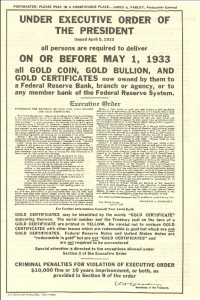
Handbill that was displayed in Post Offices calling for the recall of gold with the text of Executive Order 6102
Executive Order 6102 specifically exempted certain industrial uses of gold, art, and allowed people to keep up to $100 in face value in gold coins. It also exempted “gold coins having recognized special value to collectors of rare and unusual coins.” The protection of collectible coins was credited to Woodin since he was a collector of coins and patterns he acquired while director of the New York Federal Reserve Bank.
Although most of the country complied with the executive order, some challenged the law and started to sue the government to stop the gold recall. With the challenges mounting, on June 5, 1933, congress formally takes the United States off the gold standard by enacting a joint resolution (48 Stat. 112) nullifying the right of creditors to demand payment in gold.
For weeks after FDR issued EO 6102, the U.S. Mint continued strike gold double eagle coins because they did not have an order to stop. After receiving the stop work order, the coins were stored until they were ordered melted in 1934.
Even though the double eagles were melted, several examples of the 1933 Saint Gaudens double eagle gold coin did find its way out of the Mint. While most were tracked and confiscated, one example found its way to Egypt into the collection of King Farouk. This was the coin that eventually was sold in 2002 for $7,590,020 ($20 given to the government to monetize the coin) to a private collector. Half of the proceeds were paid to the government as part of a settlement with British coin dealer Stephen Fenton, who was arrested trying to sell the coin at the Waldorf Astoria Hotel in 1998.
-
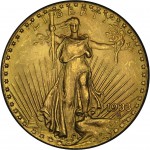
-

-
Reverse of the iconic 1933 Saint Gaudens
$20 Double Eagle gold coin
But that does not end the story of the 1933 Saint Gaudens double eagle. Since the sale of the only legal tender 1933 Double Eagle, ten coins found by the family of the late jeweler and coin dealer Israel Switt. The coins were sent to the U.S. Mint for authentication and were subsequently confiscated when they were determined to be genuine.
These coins are known as the “Langboard Hoard,” named for Joan Landbord, the daughter of Israel Switt, who claims to have found the coins while searching through her father’s old goods. On more than one occasion, Switt has been accused of being the source of the 1933 Double Eagle coins that made it out of the Philadelphia Mint.
In July 2011, a jury ruled that the 10 coins in the Langboard Hoard belong to the government. The case is currently being appealed.
The story of 1933 Saint Gaudens double eagle is truly an example of the law of unintended consequences. In an effort to rescue the economy, the cascading series of events that took the United States off the gold standard turned what was supposed to be an ordinary coin into one of the most intriguing stories of the 20th and now 21st century.
All images courtesy of Wikimedia Commons.
May 27, 2013 | celebration, coins, history
Coin Collectors Blog supports:
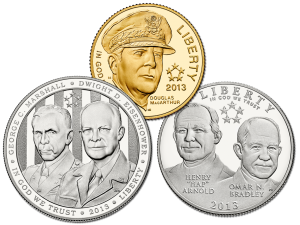 Decoration Day was first celebrated by Freedmen, freed southern slaves, May 1, 1865 in Charleston, South Carolina to honor the service of the 257 Union soldiers buried at the Washington Race Course. Today, Washington Race Course is known as Hampton Park.
Decoration Day was first celebrated by Freedmen, freed southern slaves, May 1, 1865 in Charleston, South Carolina to honor the service of the 257 Union soldiers buried at the Washington Race Course. Today, Washington Race Course is known as Hampton Park.
The next year, southern states began their own Memorial Days to honor their soldiers who died during the war. No specific date was used but occurred in late April through June. By 1880, there was a more organized Confederate Memorial Day. These celebrations honored specific soldiers to commemorate the Confederate “Lost Cause.”
In the north, the fraternal organization of Civil War veterans The Grand Army of the Republic began organizing Decoration Day celebrations in 1868. Decoration Day was the day to honor the fallen by decorating the graves of Union soldiers with flowers and flags.
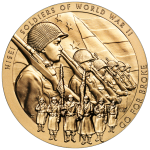
The Nisei Soldiers of World War II Bronze Medal
On this Memorial Day, I want to take this opportunity to remember those who gave the ultimate sacrifice while defending freedom at home and abroad. Whether it was wars for this country’s freedom, helping allies overseas, world wars, or helping others settle armed conflict around the globe, it is important we take this day to honor their service that helped make this country what it is today.
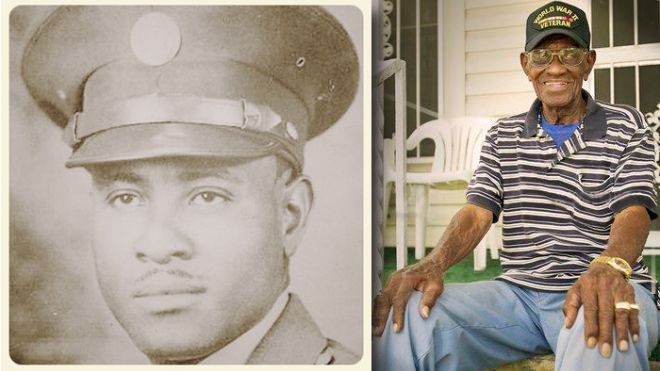
World War II veteran Richard Overton, left, is seen in his Army uniform in an undated photograph provided by the City of Austin. Overton, 107, sits outside his Texas home earlier this month. (AP/Austin American Statesman)
Coin images courtesy of the U.S. Mint.
Pictures of Richard Overton courtesy of FoxNews.com.




























